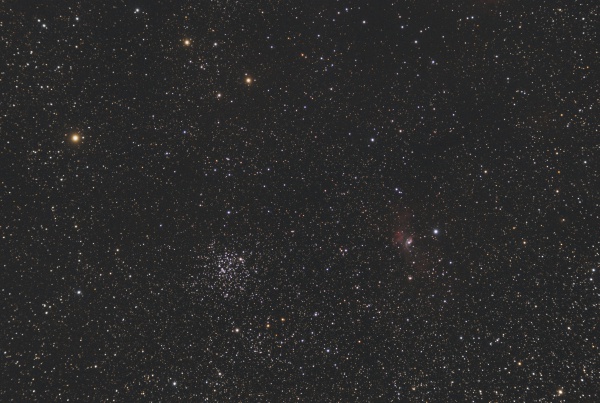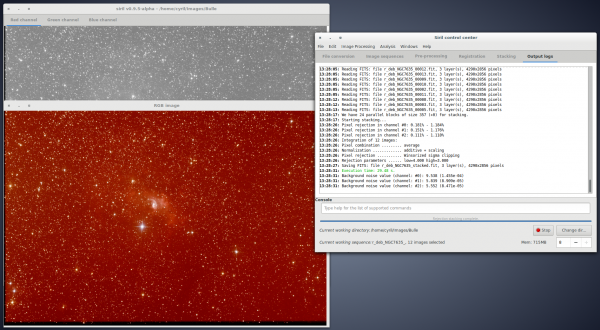No edit summary |
Created page with "Gli astronomi professionisti generalmente utilizzano immagini con profondità a 32-bit, ma Siril utilizza internamente solo immagini a 16-bit (eccetto che per lo stacking tem..." |
||
| Line 17: | Line 17: | ||
Il nuovo allineamento a rilevamento di stella è perfetto per le immagini del cielo profondo, ma ci sono anche due allineamenti a sola traslazione, uno più adatto per immagini planetarie e di nebulose luminose, basato sulla [https://it.wikipedia.org/wiki/Trasformata_discreta_di_Fourier] DFT, e un altro più semplice rivolto alle immagini del cielo profondo, basato sulla PSF di una singola stella di riferimento. Inoltre, la capacità di allineamento manuale lo rende ben adatto anche per astronomi amatoriali che hanno immagini con poche caratteristiche o di scarsa qualità, che gli strumenti di allineamento automatico non sono in grado di allineare correttamente. | Il nuovo allineamento a rilevamento di stella è perfetto per le immagini del cielo profondo, ma ci sono anche due allineamenti a sola traslazione, uno più adatto per immagini planetarie e di nebulose luminose, basato sulla [https://it.wikipedia.org/wiki/Trasformata_discreta_di_Fourier] DFT, e un altro più semplice rivolto alle immagini del cielo profondo, basato sulla PSF di una singola stella di riferimento. Inoltre, la capacità di allineamento manuale lo rende ben adatto anche per astronomi amatoriali che hanno immagini con poche caratteristiche o di scarsa qualità, che gli strumenti di allineamento automatico non sono in grado di allineare correttamente. | ||
Gli astronomi professionisti generalmente utilizzano immagini con profondità a 32-bit, ma Siril utilizza internamente solo immagini a 16-bit (eccetto che per lo stacking temporaneo). Il caricamento di immagini a 32-bit è supportato ma esse si degraderanno in quanto verranno convertite a 16-bit. Esso può comunque essere utile se l’intento è di produrre immagini per il grande pubblico. | |||
And more generally, people who want to use free software on free operating systems to process images. Siril can even be used to extract previewed frames from many videos formats. For an overview, see some image processing [[Siril:Results|results]]. | And more generally, people who want to use free software on free operating systems to process images. Siril can even be used to extract previewed frames from many videos formats. For an overview, see some image processing [[Siril:Results|results]]. | ||
Revision as of 12:40, 14 December 2016
Siril, a free astronomical image processing software
Siril is meant to be Iris for Linux (sirI-L).
Siril è uno strumento per l’elaborazione di immagini astronomiche, capace di convertire e pre-elaborare le immagini, guidare nell’allineamento automatico o manuale, nella somma e nel miglioramento delle immagini finali.
This page is the page for the new version of Siril.
Current version is 0.9.5 (stable). See the list of previous versions.

Siril è rivolto ad astronomi amatoriali che hanno acquisito delle immagini e vogliono elaborarle in modo semi-automatico. Fornisce un’interfaccia di più facile utilizzo rispetto alla linea di comando di Iris così come algoritmi di elaborazione più moderni e potenti, ma non raggiunge i livelli di automatismo di DeepSkyStacker o Registax. Esso fornisce inoltre una semplice linea di comando per accedere alle varie funzioni di elaborazione.
Siril è ora del tutto capace di pre-elaborare ed elaborare immagini del cielo profondo. Una funzionalità che è ancora assente per l’elaborazione delle immagini planetarie è la deformazione dell’immagine, ma è comunque capace di allinearle ed elaborarle in modo elegante. Il nuovo allineamento a rilevamento di stella è perfetto per le immagini del cielo profondo, ma ci sono anche due allineamenti a sola traslazione, uno più adatto per immagini planetarie e di nebulose luminose, basato sulla [1] DFT, e un altro più semplice rivolto alle immagini del cielo profondo, basato sulla PSF di una singola stella di riferimento. Inoltre, la capacità di allineamento manuale lo rende ben adatto anche per astronomi amatoriali che hanno immagini con poche caratteristiche o di scarsa qualità, che gli strumenti di allineamento automatico non sono in grado di allineare correttamente.
Gli astronomi professionisti generalmente utilizzano immagini con profondità a 32-bit, ma Siril utilizza internamente solo immagini a 16-bit (eccetto che per lo stacking temporaneo). Il caricamento di immagini a 32-bit è supportato ma esse si degraderanno in quanto verranno convertite a 16-bit. Esso può comunque essere utile se l’intento è di produrre immagini per il grande pubblico.
And more generally, people who want to use free software on free operating systems to process images. Siril can even be used to extract previewed frames from many videos formats. For an overview, see some image processing results.
News
For latest updates, see our bug and feature tracking system.
We are looking for volunteer translators, for the software and for the documentation. No programming experience is required. See the translation instructions page for software translation. In any case, check the status of your language translation with cyril (at free-astro.org) if you want to help.
The software is now considered stable. If you find bugs and want to report them (please, do!), contact the team using the links at the bottom of this page, or feel free to report them on the bug report page.
- November 28, 2016
- October 8, 2016
- October 28, 2015
- First stable version available: 0.9.0. Stability updates and minor improvements will occur in the dedicated 0.9 branch.
- June 10, 2015
- New registration method available! It is now possible to register images with an automatic global star detection tool. The algorithm takes into account the translation and the rotation.
- April 13, 2015
- We have been working hard on accelerating stacking algorithms on multi-core CPUs, giving SER a better support and we are also working on the two main lacks of Siril: taking into account rotation and multi-point in registration, for better deep-sky and planetary registrations. These works are in progress, and will take some weeks to complete.
Many improvements have been done over the previous unmaintained version. The command line has been reactivated in large proportions, see the list of currently available commands on the dedicated Commands page. New commands and features have been and are being developed. For a complete list of features, see the 0.9.4 page, the roadmap, or the list of features below.
The roadmap for Siril is being updated for its after-release life. Ideas are stored in the Roadmap page, and the list of known bugs is maintained in the bug tracking page file. The complete changelog is available in the SVN log, a summary is available in the news section above and in the page of each release, as well as in the ChangeLog file. If you want to contribute, you are welcome!
Start using Siril / Documentation
Siril's works internally with FITS images, unsigned 16-bit per pixel and per channel. All images you want to process with Siril have to be converted using the Conversion tab, except for SER and film sequences which are converted on-the-fly.
For pre-processing, Siril applies master offset/bias, dark and flat images to the current sequence. These master images thus have to be processed before processing the actual image sequence. Siril currently does not support processing multiple sequences at the same time, so each layer of the final image must be processed independently before assembling them into an RGB image.
A new Web-based documentation or PDF format for offline viewing, contain illustrated instructions on how to use particular features of Siril, along with a few videos to illustrate or describe these capabilities.
List of Siril features
New features are being introduced quite regularly. Here is a list of main features:
- Native image format support
- Unsigned 16-bit FITS files (other FITS are converted to this format on-the-fly)
- SER files
- AVI and many other film files, their support is being dropped in favour of SER.
- Image conversion (to the native FITS format only)
- Supported input types: 8-bit and 16-bit BMP, TIFF, JPEG, PNG files, NetPBM binary images, RAW DSLR images.
- Pre-processing of images with multi-channel offset, dark and flat images
- Image registration; supported methods:
- Global star alignment (rotation + translation)
- Translation using DFT centered on an object, generally used for planetary images
- Translation using PSF of a star, generally used for deek-sky images
- Manual translation with two preview renderings of the current image with reference frame in transparency
- Registered sequence export
- Supported export file formats: Siril FITS sequence, SER sequence, uncompressed AVI files, GIF up to 0.9.4, MP4 and WEBM web publising video formats since 0.9.5
- Optionnal cropping and resizing of the exported images
- Image stacking
- Summing
- Median
- Percentile clipping
- Sigma clipping
- Median sigma clipping
- Winsorized sigma clipping
- Linear fit clipping
- Pixel minimum/maximum
- Enhancement and processing of final images
- Lightness/contrast cursors on each layer, different scaling modes (linear, log, square root, squared, asinh, histogram equalisation), negative and false colour rendering and clipping
- Background removal tool
- Cosmetic correction tool
- A command line for various processing functions, only available from the GUI, see the list of available commands.
- A star finding algorithm with PSF information
- Image compositing tool, combining and aligning multiple layers (1 to 6) with custom colours into a resulting image, with luminance layer support
Compilation and installation
See Siril installation page. It documents which binary packages you can get and how to build from source if needed, for multiple operating systems. Siril is a free software, licence is GPL3. It will most likely never run or be supported on Windows family operating systems.
Who is behind Siril?
Vincent is a computer scientist (PhD) and uses Siril as an amateur to process images from a Canon EOS, a QSI and a Basler camera on a 410mm telescope.
Cyril is a physicist (PhD), now IT engineer at CNRS, motivating new developments and providing high quality processing algorithms to Siril.
Laurent is a senior IT project manager and also uses Siril to process images from a Canon EOS and a ZWO camera on a 254mm telescope. He manages the formatting of the documentation, using Scenari technology.
François Meyer wrote the initial (up to v0.8) versions. Here are the legacy Sourceforge project and website.
See the AUTHORS file for the complete list of contributors.
If you like the software, please help us by contributing with the Donate button on the top right. Siril took us a lot of time and we still have to pay for the server.
